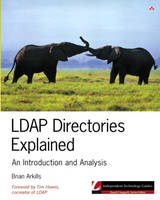
LDAP Directories Explained
Addison Wesley (Verlag)
978-0-201-78792-4 (ISBN)
- Titel ist leider vergriffen;
keine Neuauflage - Artikel merken
Directory services matter to nearly every organization because they help centrally manage information and thereby reduce the costs of computing services. LDAP (Lightweight Directory Access Protocol) is a set of protocols that have become the internet standard for accessing directories. Many people need to understand directory services and LDAP in order to make decisions for their business. The books currently available are too advanced for technical managers and those new to directory services. This book is designed to fill that need. The author spends the first half of the book exploring how directory services and LDAP work and then the second half discussing the most popular implementations - OpenLDAP, Microsoft Active Directory, and Directory Server - for those who are trying to compare products. This book provides the technical foundation that will enable IT managers to make sound business decisions and developers to move on to more advanced books.
Brian Arkills works as a software engineer at the University of Washington, where he performs systems administration, analysis, and project management. While at Stanford University, Brian used LDAP technology to extend Stanford's existing Netscape Directory Services to Microsoft clients via Microsoft Active Directory. In doing so, he found that there were no quality books that provided a basic introduction to the technology. He wrote this guide to fill that need. 020178792XAB01292003
Foreword.
Preface.
Acknowledgments.
I. HOW LDAP WORKS.
1 Overview of LDAP.
Introducing Directories.
Structure.
Content and Usefulness.
Benefits of a Directory.
Introducing LDAP.
Mycompany.com.
Namespace.
Protocol.
Schema.
Management.
Vendor LDAP Products.
Why Choose LDAP?
2 LDAPNamespace.
DNS.
DNS Hierarchy.
DNS Resolution.
Basic DNS Record Types.
How LDAP Uses DNS.
LDAP Object Structure.
Allowed Structures.
LDAPContainers.
Structure Rules.
Naming Contexts.
LDAP Object Naming.
Relative Distinguished Name (RDN).
Naming Attributes.
Distinguished Name (DN).
Naming Special Characters.
URLNaming.
LDAP v2 Naming Conventions.
Special LDAP Structural Concepts.
Summary.
3. Client LDAP Operations.
Directory-Enabled Services and Applications.
Search.
Mandatory Search Parameters.
Optional Search Parameters.
Search Filters.
LDAPProtocol.
LDAPOperations.
LDAPControls.
LDAP Client Options.
APIs.
Summary.
Appendix Material.
4. LDAPSchema.
Object Classes.
Elements of an Object Class.
Creating the Entry You Want.
Attributes.
Elements of an Attribute Type.
Attribute Subtypes.
Attribute Options.
Operational Attributes.
Syntaxes.
Matching Rules.
OIDs.
Schema Checking.
Extended Schema Definitions.
DNS Extensions.
extensibleObject Object Class.
dynamicObject Object Class.
Java.
inetOrgPerson Object Class.
Still in Development.
Summary.
Appendix Material.
5. Directory Management.
Replication.
Partitions.
Replicas.
Referrals.
Referral Resolution.
Referral Syntax.
Referral Examples.
Chaining.
Aliases
Distributed Directory.
Reliability.
Replication Topology.
Maintenance.
Integrating Independent Directories.
Data Architecture Management.
Metadirectories: Glue Together Your Directories.
Master Directory.
Directory Synchronization.
Loose Directory Interconnection.
Harvesting Data (Connectors).
Moving Data Between Directories.
LDIF.
DSML.
Directory Security.
Authentication.
Authorization.
Encryption.
Administrative Server Parameters.
Other Directory Management Tasks.
Summary.
II. HOW VENDORS HAVE IMPLEMENTED LDAP.
6. OpenLDAP.
Namespace.
Naming Contexts and Partitions.
Distributed Directory Functionality.
Database Functionality.
Indexing.
Operations and Clients.
Clients.
Controls.
Schema.
Classes.
Attributes.
Management.
Special Configuration Parameters.
Security.
Authentication.
Authorization.
Privacy.
Why OpenLDAP?
7. Microsoft Active Directory.
Namespace.
DNS.
Directory Namespace.
Sites.
Naming Contexts and Partitions.
Global Catalog.
Operations and Clients.
Clients.
Controls.
Directory-Enabled Services.
Schema.
Classes.
Attributes.
Management.
Replication.
Indexing.
Data Architecture.
Special Configuration Parameters.
Security.
Authentication.
Authorization.
Privacy.
Why Active Directory?
8. Directory Server.
Namespace.
Naming Contexts.
Database Functionality.
Indexing.
Referrals.
Chaining.
Operations and Clients.
Clients.
Controls.
Plug-ins.
Schema.
Groups.
Roles.
Class of Service (CoS).
Management.
Replication.
Special Configuration Parameters.
Security.
Authentication.
Authorization.
Privacy.
Why Directory Server?
APPENDIXES.
A. Client LDAP Operations Appendix.
Draft Controls.
PSEARCH.
TSEARCH.
DIRSYNC.
LCUP.
Chaining.
Virtual List View.
C language API.
B. Schema Appendix.
Schema Formats.
ASN.1 Object Class Syntax.
ASN.1 Attribute Syntax.
BNF Object Class Syntax.
BNF Attribute Syntax.
Slapd.conf Object Class Syntax.
Slapd.conf Attribute Syntax.
Common Syntaxes.
Common Matching Rules.
C. Stanford University Directory Architecture.
Environment.
Source Systems.
Stanford Registry.
Privacy Controls.
Directory Harvester.
Event Database.
Stanford Directory.
E-mail Service Integration.
Web UI Integration.
Updating Your Personal Information.
Active Directory Harvester.
Privacy Control in AD.
Summary.
D. OpenLDAP Access Control.
Element.
Element.
Element.
Evaluation of Access.
Comprehensive Example.
E. Active Directory Controls Appendix.
F. Directory Server Appendix.
Default Indexes.
Access Control Instructions (ACIs).
ACI Targets.
ACI Heading.
ACI Permissions.
ACI Bind Rules.
Putting an ACI Together.
Macro ACIs.
Plug-ins.
G. Online Reference Material.
Chapter 1 Topics.
Articles.
LDAPSupersites.
Chapter 2 Topics.
DNS.
Referrals.
Escaping Special Characters.
Chapter 3 Topics.
Programming Resources.
Encoding Resources.
Directory Integration.
Chapter 4 Topics.
X.500.
ASN.1.
Schema Resources.
Chapter 5 Topics.
Metadirectories.
DSML.
Security.
Stanford University.
Chapter 6 Topics.
Building OpenLDAP.
OpenLDAP Admin Guide.
Mailing List Archives.
Chapter 7 Topics.
Linked Attributes.
Chapter 8 Topics.
Server Documentation.
Programming Resources.
Index. 020178792XT01292003
| Erscheint lt. Verlag | 2.3.2003 |
|---|---|
| Reihe/Serie | Independent Technology Guides |
| Verlagsort | Boston |
| Sprache | englisch |
| Maße | 189 x 235 mm |
| Gewicht | 740 g |
| Themenwelt | Informatik ► Netzwerke ► LDAP / Active Directory |
| ISBN-10 | 0-201-78792-X / 020178792X |
| ISBN-13 | 978-0-201-78792-4 / 9780201787924 |
| Zustand | Neuware |
| Haben Sie eine Frage zum Produkt? |